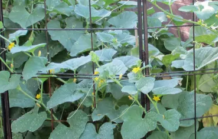Driving west out of the Sandhills into the quaint little community of Hay Springs something caught my eye—large ponderosa pines towering above the other trees on a side street. I was amazed at the size of the trees and decided to investigate. What I discovered was simply lovely, big ponderosa pines shading a small bungalow home. The trees had been planted close to the west side of the home when they were young, presumably to act as a windbreak. As the trees grew and the branches began to cover the sidewalk, they were limbed up (pines do this naturally in the forest so the homeowners were just following nature’s lead).
What was accomplished by this planting was full shade in the afternoon and easy access to walk or drive below the branches. What a fortunate homeowner to have this native, drought-tolerant tree shield the home from the hot afternoon sun. I had seen something similar in Imperial—a large ponderosa pine towering over the east side of a home. It made me wonder, are we using the right trees for shade, particularly in our western communities?
Pines, especially ponderosa, are very effective shade trees if placed in the proper location and with careful consideration about their mature size. Keeping our homes cool in summer is highly important, but will this prevent sun from warming the home in the winter? South and western sun exposure in winter warms the home and reduces energy use, so placing them on the east or southeast side allows both summer shade as well as winter sun.
Drifting snow should also be considered. Placing trees west or north of buildings may cause snow drifts on sidewalks, driveways and home entrances. In some locations it will help capture winter moisture for plants but the drifts may also limit pathways when the trees are young and not limbed up. Winter shade on the south side of drives, sidewalks and roads running east/west also can prevent snow and ice from melting and cause safety issues (and salting these areas is not an option since pines are not tolerant of salts).
Using pines as shade trees certainly has benefits. Pines are drought-tolerant and, in fact, overwatered pines will actually decline so they are an ideal tree for homeowners interested in xeriscaping. They prefer sandy soil and pH of 6-7 but can handle the heavier, higher pH soils of western Nebraska. The high canopy of some pines lends itself to shade and ponderosa and white pine, with their canopy spread of about 20 feet, can exist in confined spaces. Generally deep-rooted, they don’t create problematic surface roots but seek moisture from deeper in the soil profile.
Pines provide habitat to numerous insects, mammals and birds, including two birds in the finch family—the red crossbill which has a beak specially adapted to pine seeds and the pine siskin which prefers ponderosa pine for nesting. Insects that make their home in pines, particularly the bark beetles, are ideal food for woodpeckers.
Beyond wildlife habitat, they also provide a desirable landscape resource—MULCH! They are great at producing their own. The 5-10” long needles weave together and create a blanket over the landscape which insulates the roots from temperature fluctuations, helps retains moisture and seldom blows away. Pine straw, as it is typically referred to, allows homeowners to affordably create large, natural mulched beds where pines and understory plantings can thrive with reduced competition from turfgrass.
Large deciduous trees should be the dominant species of our community forests but I’m beginning to think native pines should be given more consideration when we’re selecting “shade” trees.




